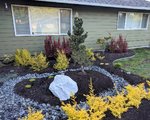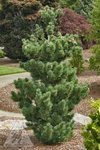mister_project
Seedling
I hope it's not bad form for me to ask a question about niwaki on this forum and apologize in advance if it is. I recently acquired a Kotobuki Japanese black pine that is about 4' tall, which I think puts it somewhere in the 5-10 year old range. I've attached a picture below. I've been wanting to try my hand at creating a niwaki style tree using a black pine for a while now. In retrospect, I'm not sure that the Kotobuki is the best specimen to try this on given its growth habits, but hindsight is 20/20. It was also all I could get my hands on and I'd like to give it a shot as an experiment if nothing else. I live in WA state in zone 8b. I got the tree on April 20th of this year and planted it immediately.
Given that the tree is a little bit more on the mature side I'd like to get to structural pruning and bending the branches into the correct form sooner rather than later before the branches develop too much. A lot of pruning will be required to thin the branches out. Youtube guides for pruning more common types of Japanese black pines indicate that if done at the correct time of the year, black pines can withstand significant structural pruning without issue. Summer was recommended as prime time oddly enough, but I've also seen the more typical autumn recommendations. I'm a bit nervous to cut huge amounts of the tree away right now considering I planted the tree only several weeks ago. When should I wait until to start significant pruning without fear of stressing the tree too much?
Second, when I am able to start structurally pruning the tree to form is there any recommended limit as to how much I should cut away in a single season? The guide I mentioned showed what I'd guess was at least 50%-70% removal of the tree's structure in one go. That seemed like a lot of stress to put on the tree to me, but perhaps I'm overthinking it. I wasn't sure if that was still okay for younger trees that were less established as well.
Thanks for any and all help!

Given that the tree is a little bit more on the mature side I'd like to get to structural pruning and bending the branches into the correct form sooner rather than later before the branches develop too much. A lot of pruning will be required to thin the branches out. Youtube guides for pruning more common types of Japanese black pines indicate that if done at the correct time of the year, black pines can withstand significant structural pruning without issue. Summer was recommended as prime time oddly enough, but I've also seen the more typical autumn recommendations. I'm a bit nervous to cut huge amounts of the tree away right now considering I planted the tree only several weeks ago. When should I wait until to start significant pruning without fear of stressing the tree too much?
Second, when I am able to start structurally pruning the tree to form is there any recommended limit as to how much I should cut away in a single season? The guide I mentioned showed what I'd guess was at least 50%-70% removal of the tree's structure in one go. That seemed like a lot of stress to put on the tree to me, but perhaps I'm overthinking it. I wasn't sure if that was still okay for younger trees that were less established as well.
Thanks for any and all help!



